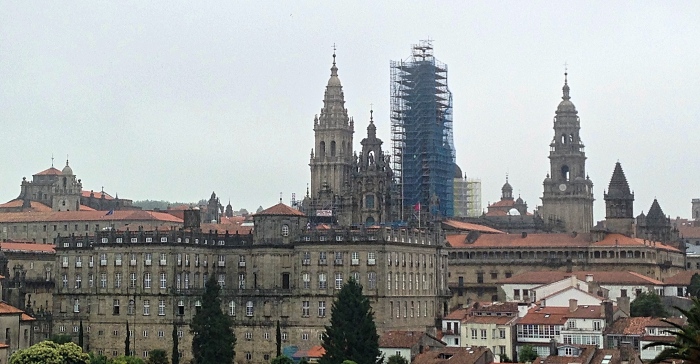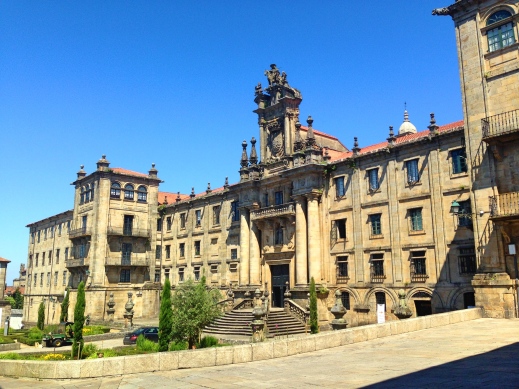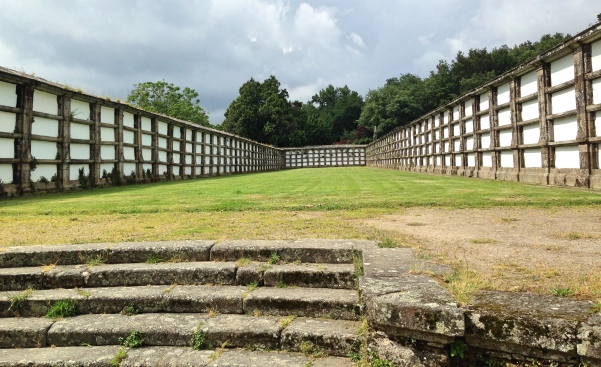Well over a year ago, after completing my short camino, I spent some time exploring the city of Santiago de Compostela. Procrastination prevented me from doing a timely blog post. So with the benefit of hindsight but penalty of forgetting, I will complete this long overdue write-up.

Santiago de Compostela is a remote and storied city. Situated in the province of Galicia, in the north-west of the Iberian Peninsula, far from Spain’s capital and remote from the rest of Europe, it has never been the crucible of a religion nor the seat of an empire. Probably we would never have mentioned it had it not been for one shepherd who, one day, over a thousand years ago, reported seeing a light over a field. Those who followed this light found a tomb; and inside, the body of St. James the Greater.
As I discussed in my post about the Camino de Santiago, this story is an apocryphal legend. What is certain is that the Christians in the north of Spain were in trouble. During the last one hundred years, Muslims had poured into the Iberian Peninsula, conquering everything with effortless ease. These Muslims relied on irrigation for their agriculture—the combination of the crops and the technologies they brought with them forever transformed Iberian farming—so they had trouble colonizing mountainous regions. So it was these northern, rainy, and mountainous areas to which many of the Christians retreated, huddling in modern-day Galicia and Asturias.
Outmanned, disorganized, technologically and culturally outmatched, these Christians had little hope of defeating the Muslims southward. But the “discovery” of St. James’s body helped to change this situation. Suddenly, an obscure, rural, and remote area of a Christian outpost became one of the most important holy sites in Christendom, comparable with Rome or Jerusalem. Eventually, the Christians of northern Spain expanded their territory, extending their dominion along the northern coast all the way to the Pyrenees. Once linked up with France, pilgrims began to pour into the country, seeking penance and repentance through the journey.
The cultural effects of this pilgrimage could hardly be overstated. By this time, Europe had emerged from the confusion which followed Rome’s collapse, and daring new architectural styles were being developed: the Romanesque, Gothic, and later Renaissance and Baroque. The Camino de Santiago became the artery through which these styles flowed into Spain; and as a result, some of the most splendid cathedrals in the country can be found along the route: the gothic cathedrals in León and Burgos, for example, and the magnificent Romanesque cathedral of Santiago itself. And it is this cathedral that any visitor to the city must turn to first.

The Cathedral of Santiago is the end-point of the entire camino, the iconic goal of the arduous pilgrimage. And the building is worth the walk.
According to legend, the cathedral was built over the tomb of St. James. This church quickly became a potent symbol of Christianity, prompting the Moors in 997 to invade, burn down the early church, and take the bells and the gates with them back to their capital in Córdoba, where this bounty was placed—appropriately enough—in the Great Mosque. When King Ferdinand III of Castile conquered Córdoba over two hundreds years later, he had the same bells and gates transported to the Cathedral of Toledo, where they remain to this day.
The front entrance of the cathedral stands proudly above the Plaza de Obradoiro (gallego for “workshop”), a monumental square that, on any given day, is full of exhausted pilgrims and energetic street vendors. This square, and the two baroque spires of the cathedral’s façade, owe their current form to Fernando de Casas Novoa, who undertook the work in the early 18th century. Though a relatively obscure architect, Novoa achieved a stupendous result. The façade sweeps upward like an orchestral crescendo, its symmetrical ornamentation perfectly balanced between a strong upward vertical push and swelling curves, embellished at every point by intricate friezes.
This would be enough to make any cathedral notable; but the Santiago Cathedral has three more impressive façades: on the northern, southern, and eastern ends. And each of these façades overlooks plazas of almost equal grandeur. Counterbalancing the two spires at the western entrance is the clock tower, another elegant Baroque skyscraper. The pilgrim can thus walk 360 degrees around the building without ceasing to find something to attract his eye.

And yet the most beautiful portal of the cathedral is not visible from the outside at all. It is the Pórtico de la Gloria—which, because of the subsequently built baroque exterior, now stands on the inside of the western entrance. Designed by Master Mateo in the late 12th century, this portal is now considered to be one of the masterpieces of Romanesque sculpture. Tragically—for me—this site was closed when I arrived in Santiago, so I did not have the privilege of beholding it. But I did get a chance to see some sculptures from this portico in the Prado, where they were transported during repair-work in Santiago—and even this small sample was extraordinary.
Like so many secular pilgrims, I decided to go to a “pilgrim’s mass” in the cathedral, to take part in the religious tradition. These are held throughout the day, in multiple languages, and are abbreviated compared with the usual mass. I was hoping to see the famous botafumeiro, but it made no appearance. This is a giant censer—or incense burner—that is swung from the ceiling during masses on religious holidays. If you haven’t seen a video, I recommend it; the censer swings wildly, spilling forth perfumed smoke into the cavernous church. A team of eight men is needed to get it going; and it costs the cathedral nearly $500 every time this ceremony is performed. Swinging a giant metal object full of burning coals would seem to come with certain risks; and indeed the censer has flown off its rope many times—though I believe no one has ever been seriously hurt.

After the mass was finished, I got in line to ascend to the main altar. This is a magnificent mass of gold and smiling angels, whose lithe bodies lift the shimmering metal towards heaven. In the center of this arrangement, seated under Jesus, is a statue St. James himself; and it is considered good luck to lay one’s hand on his back. (I am not sure if this statue is a reliquary or just an icon.) This deed having been performed, I leapt down to explore the rest of the cathedral. Signs are posted on every wall, with a schedule for mass in English, French, German, Italian, Japanese…. to be held in one of the cathedral’s many attractive chapels. The cathedral’s ceiling has the characteristic rounded barrel vault of Romanesque structures; and surface after surface is adorned with the signature scallop shell of the camino.
Once you exit the cathedral, and finish your long circuit around the outside, you will end up once again in the Plaza de Obradoiro. Here there is yet another notable landmark: the Hostal de los Reyes Católicos. As you face the cathedral’s western entrance, this venerable building stands to your left. It was originally a hostel, commissioned by the Catholic Monarchs, Isabel and Ferdinand, for weary pilgrims finishing their journey. A lovely platersque façade adorns the main doors of this building; but beyond this I could not venture, for nowadays the hostel is a Parador de Turísimo: an old building refurbished into a fancy hotel for wealthy guests. The old hostel does honor its roots by offering a free meal to pilgrims—the first ten who walk in the doors, that is. I didn’t try my luck.

Facing the northern façade of the cathedral is yet another landmark: the Monasterio de San Martín Pinario. This is the second largest monastery in the country, after El Escorial. The side facing the cathedral is fronted with a lovely garden, but the visitor cannot enter here; rather you must go around the corner, at the church entrance, where a sweeping staircase takes you underneath an imposing sculptural display of saints. Inside, you will find a golden altar in a high-walled church. Unlike in so many churches—since this one is no longer in use—you are allowed to walk wherever you please, onto or behind the main altar, or up into the choir, which gives you a priest’s-eye view of the church.

Like the Monasterio de Santo Tomás in Ávila, this monastery also previously served as a center of scientific research: inside there was a collection of bird specimens, a surprisingly accurate anatomical model, and a collection of old chemical containers on display. This monastery was confiscated by the central government at around the same time as the Monasterio de Piedra in Zaragoza, in 1835, during the Carlist War. Thankfully, unlike the Monasterio de Piedra it was not burned, and was finally given over to be used as a seminary, a use which it retains to this day.

The “casco viejo” (historical center) of Santiago is itself a monument. As in Toledo, Córdoba, or Cáceres, the narrow, twisting, tightly packed medieval streets have been preserved. Small squares centered around statuesque fountains, churches with their stone crucifixes sticking from the street—this was the old city, which, like everything else in Galicia, was made almost exclusively from the deep grey granite so abundant in the region. The constant presence of this somber silvery stone, juxtaposed with the cool green of the countryside, is one of the most characteristic features of this part of Spain.
One of the finest parks in the city is the Parque de Alameda, which provides some excellent relief from the occasionally claustrophobic center. This park is most notable for its lookout point, which provides the best view of the Santiago Cathedral in the city (see the headline image above). Unfortunately for me, this view was partially obscured by the scaffolding erected around one of the towers, as part of the cathedral’s extensive maintenance work. Santiago’s other notable park is the Parque de Santo Domingo de Bonival, a Romantic garden filled with stone fragments and ruins, in the grounds of a former convent. The park still preserves a cemetery—in which, quite unlike American cemeteries, the bodies are interred in shelves built into long walls.

The convent to which this cemetery belonged was possessed by the Spanish government during the same wave of confiscations that took the Monasterio de San Martín Pinario. The beautiful church still stands, and is now used for events—I briefly peeked inside, but they were performing renovations. The convent itself has also been repurposed. Nowadays it is home to the Museo de Pobo Galego. “Pobo Galego” is gallego (the language of Galicia) for el Pueblo Gallego, or the Galician People, and is without doubt one of the best museums in the city.
Compared to both the Basques and the Catalans, the Galicians have been relatively free from separatist and nationalist movements. Yet as a region, Galicia is arguably as distinct from the rest of Spain as those better-known examples. Gallego is one of Spain’s four official languages—along with Spanish, Basque, and Catalan—and is widely spoken in the region. Written down, gallego looks extremely similar to Portuguese, but I do not believe the two languages are mutually intelligible. For what it’s worth, the traveler George Henry Borrow—who was a genius in languages and could speak over twenty—reported being dumbfounded by the language, despite being fluent in Portuguese and Spanish.

Appropriately enough, gallego is abundant in the Museum of the Galician People. This museum is dedicated to preserving some of the distinct cultural traditions of the region—many of which are sinking into obscurity, due to technological innovation and the spread of mainstream Spanish culture. The museum is full of models and replicas: of buildings, costumes, fishing nets, musical instruments, farming implements, and even traditional fishing vessels, all accompanied with extensive information. To someone with an anthropological background, like me, it was enchanting. The highlight of the museum was, however, not an exhibit at all, but the picturesque double-helix staircase that was part of the erstwhile monastery.

My last stop was the Museo de las Peregrinaciones, or the Pilgrimage Museum. This turned out to be far more interesting than I expected. Not only was there a good historical overview of the Camino de Santiago—complete with examples of guidebooks from many centuries and countries, including a huge hand-drawn guidebook in Japanese—but there was also information about pilgrimage as a human phenomenon.

Europe, of course, is not the only place that has turned the simple act of moving into a religious rite. The hajj is one of the five pillars of Islam; and today the journey to Mecca is undertaken by millions every year. Aside from the Camino de Santiago, the pilgrimage routes of Kumano Kodo, in Japan, is the only UNESCO-recognized walking path—and journeys on foot have as long and venerable a history in Japan as anywhere.
And this is not to mention the examples from literature. The Odyssey is the West’s foundational and proverbial example of a transformative journey; and Chaucer’s Canterbury Tales takes place on a pilgrimage. In Japan, Matsuo Basho’s famous collection of Haiku’s, The Narrow Road to the Deep North, was written during his wanderings on foot. But naming individual works cannot do justice to the idea of pilgrimage, since nearly every iconic story involves a journey of some kind.
Why is it that humans, from around the world and across history, have discovered a spiritual significance in travel? The new sites and sounds, foreign cities and strange customs, hold an obvious appeal. The privations induced by travel reduce life to its most basic elements, perhaps reminding pilgrims of what is important and what is frivolous. The act of the journey easily lends itself as a metaphor for the transformation of the traveler, whose outlook is shifted as much as his body. The withdrawal from one’s usual surroundings gives the pilgrim time to think and reflect during the long hours on the road. And the act of throwing one’s fortune to the winds—away from the safety of one’s home, navigating unfamiliar obstacles—has obvious religious implications.
Pilgrimage represents travel at its best—the seeking of wisdom, simplicity, and community, the sense of adventure, the willingness to adapt, the striving for understanding—and Santiago de Compostela is, as I discovered, an ideal place for pilgrims of all nations.
A accurate and good report of the journey and description of Santiago Lotz (jose moa)
LikeLiked by 1 person
Thank you very much!
LikeLike
Ma carissimo Roy, hai abbondonato l’italiano per la lingua di Cervantes? Ok, ma spero che ogni tanto apri un libro di Dante per godere il dolce stil nuovo ed i suoni velluti della tua prima lingua dai tuoi anni con me a SH
Un abbraccio forte forte
M Noll
LikeLiked by 1 person
Thanks for the comment Ms. Noll! Yes I’m afraid I’ve lost almost all of my Italian. But I hope that my Spanish will make re-learning Dante’s language rather easier.
Un abrazo muy fuerte,
Roy
LikeLike